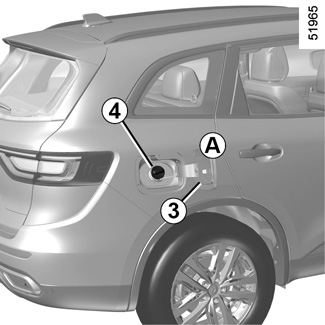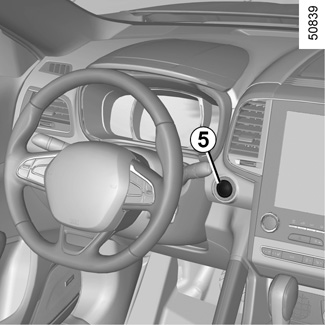FUEL TANK



Useful capacity of tank:
- Approximately 60 litres for all models;
To open the cover A, pull the control 1.
Use the cap holder 3 on the flap A during filling to hold the cap 2 (diesel version) or the cap 4 (petrol version) in place.
Fuel grade
Use a high-grade fuel that complies with the legislation in force in each country and which must comply with the specifications given on the label on the cover A. ENGINE SPECIFICATIONS
Petrol version
It is essential to use unleaded petrol. The octane rating (RON) must comply with the information given on the label on the cover A. ENGINE SPECIFICATIONS
Diesel version
Only use diesel fuel which complies with the information on the label located inside the cover A.
After filling, check that the cap and cover are closed.
Never press valve 2 with your fingers.
Do not wash the filler area with a high-pressure washer.
Do not mix even small amounts of petrol (unleaded or E85) with diesel.
Do not use ethanol-based fuel if your vehicle is not compatible with this fuel.
Do not add anything to the fuel (additive, reagent, etc) to prevent the risk of damaging the engine.
Filler cap: this is specific.
If you have to replace it, make sure it is identical to the original cap. Contact an approved Dealer.
Never place the cap near a source of heat or flame.
Do not wash the filler area with a high-pressure washer.
Filling with fuel
With the ignition off, insert the nozzle and insert it fully before turning it on to fill the fuel tank (risk of splashing).
Keep the nozzle in this position throughout the entire filling operation.
When the pump cuts out automatically at the end of the filling procedure, a maximum of two further filling attempts may be made, as there must be sufficient space in the fuel tank to allow for expansion.
Make sure that no water enters the tank during filling. The cover A and its surround must remain clean.
Petrol versions
Using diesel fuel will damage the antipollution system and may lead to a loss of warranty.
To ensure that the fuel tank is not filled with diesel fuel, the fuel tank filler neck consists of a restrictor fitted with a safety system which only allows a nozzle for petrol to be used (at the pump).
Fuel types that conform to European standards with which the engines of vehicles sold in Europe are compatible: ENGINE SPECIFICATIONS
To fill up with fuel, the engine must be stopped (and not only on standby in case of vehicles equipped with the STOP and START function): you MUST switch off the ignition. STARTING, STOPPING THE ENGINE: vehicle with key or STARTING, STOPPING THE ENGINE: vehicle with RENAULT card
Running out of fuel on diesel versions
Vehicles with key/remote control
- Put the ignition key in “ON” position IGNITION SWITCH: vehicle with key and wait for a few minutes before starting, to enable the fuel circuit to be primed;
- turn the key to “START”. If the engine does not start, repeat the procedure.
- If the engine does not start after several attempts, please contact an authorised dealer.

Vehicles with RENAULT card
With the card RENAULT in the passenger compartment, press the start button 5 without pressing any of the pedals. Wait a few minutes before starting. This will enable the fuel circuit to be primed. If the engine does not start, repeat the procedure.
If the engine does not start after several attempts, please contact an authorised dealer.
No modifications whatsoever are permitted on any part of the fuel supply system (electronic units, wiring, fuel circuit, injectors, protective covers, etc.) as this may be dangerous (unless undertaken by qualified Network personnel).
Persistent smell of fuel
If you notice a persistent smell of fuel you should:
- stop the vehicle as soon as traffic conditions allow and switch off the ignition;
- switch on the hazard warning lights and ask your passengers to leave the vehicle and stay clear of the traffic;
- contact an approved Dealer.